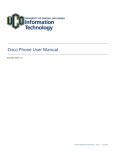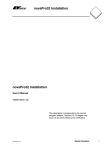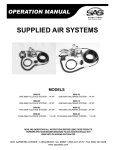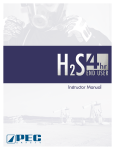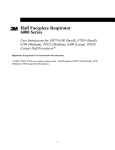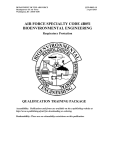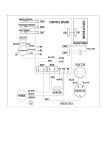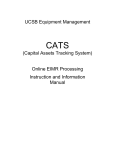Download Roger Williams University Respiratory Protection Program
Transcript
Last Updated: March 2009 Roger Williams University Respiratory Protection Program Department of Environmental Health and Safety Roger Williams University One Old Ferry Road Bristol, RI, 02809 Last updated: March 2009 TABLE OF CONTENTS Respiratory Protection Plan -1- Last Updated: March 2009 ADMINISTRATIVE INFORMATION Introduction and Purpose of Program ………………………………………………………..3 Site Information, Application, and Scope of Program ………………………………………3-5 Program Administrator …………………………………………………………………………5 Program Evaluation …………………………………………………………………………5 Recordkeeping ………………………………………………………………………………….6 REQUIREMENTS TO BE MET PRIOR TO RESPIRATOR USE Medical Evaluation …………………………………………………………………………7-8 Fit Testing Procedures …………………………………………………………………………8-9 RESPIRATOR USE AND MAINTENANCE Selection ………………………………………………………………………………….10 Filter, Cartridge, and Canister Identification ……………………………………………….10-14 Training ………………………………………………………………………………….14-15 Use …………………………………………………………………………………………..15 Facepiece Seal …………………………………………………………………………15 Continuing Respirator Effectiveness ……………………………………………….16 Maintenance ………………………………………………………………………………….16-18 Cleaning and Disinfecting ………………………………………………………..16 Storage ………………………………………………………………………………….16-17 Inspection …………………………………………………………………………17 Repairs ………………………………………………………………………………….17-18 APPENDICES A-0: OSHA 29 CFR 1910.134 Respiratory Protection Standard A: OSHA 29 CFR 1910.134 Appendix A (Fit Testing Procedures) B-1: OSHA 29 CFR 1910.134 Appendix B-1 (User Seal Check Procedures) B-2: OSHA 29 CFR 1910.134 Appendix B-2 (Respirator Cleaning Procedures) C: OSHA 29 CFR 1910.134 Appendix C (Medical Evaluation Questionnaire) D: OSHA 29 CFR 1910.134 Appendix D (Voluntary Use Form) E: OSHA 29 CFR 1910.1000 Tables Z-1, Z-2, and Z-3 (Permissible Exposure Limits) F: NIOSH 2005-100 Respirator Selection Logic (2004) G: RWU Fit Testing Form H: RWU Supplemental Information Form for the PLHCP I: Irritant Smoke (Stannic Chloride) MSDS J: Proper Disposal of Irritant Smoke Tubes and Debris K: Respiratory Protection Program Amendments L: Manufacturer’s Information Packet (3M 6000 Series Half Facepiece) M: Manufacturer’s Information Packet (3M Cartridge User’s Guide – Multi Gas and Mercury Vapor) N: Respirator Inspection Forms O: Respirator Cartridge Change Schedule Requirements P: Case Studies P-1: SAAHP 135, Formaldehyde Vapors P-2: Recreation Center Lower Mechanical Room, Chlorine Vapors Respiratory Protection Plan -2- Last Updated: March 2009 ADMINISTRATIVE INFORMATION Introduction and Purpose of Program (A) The Occupational Safety and Health Administration (OSHA) regulations set forth in 29 CFR 1910.134 address respiratory protection in the workplace. The regulations in this section seek to “prevent atmospheric contamination…[to control] those occupational diseases caused by breathing air contaminated with harmful dusts, fogs, fumes, mists, gases, smokes, sprays, [and] vapors” (29 CFR 1910.134(a)(1)). (B) Roger Williams University (RWU) shall first seek to prevent atmospheric contamination by implementing engineering controls whenever possible, prior to utilizing personal protective equipment. Engineering controls can include enclosing the work area, introducing ventilation (local and general), and/or substitution of less toxic materials. After engineering controls are in place, respirators (personal protective equipment) can be employed if deemed necessary. If respirators must be used to make the work environment safe, then their use shall be governed by this written, worksite-specific respiratory protection program (RPP). The RPP shall describe all aspects pertaining to the safe use and maintenance of university-issued respirators. RWU shall issue respirators for use at no cost by medically cleared and properly trained employees enrolled in the RPP, and will develop, implement, and maintain the RPP to ensure the continued safe usage of these respirators. Site Information, Applicability, and Scope of Program Site Information: (A) Roger Williams University is a private liberal arts university. Roger Williams University’s main Bristol campus is located on the Mount Hope Bay and hosts undergraduate programs, graduate programs, and the School of Law. Additionally, RWU has satellite campuses and offices in downtown Bristol, Tiverton, Portsmouth, and Providence, Rhode Island, and offcampus dormitories in Bristol. Applicability and Scope: (A) This RPP applies to all RWU employees working in conditions that require the use of a respirator while at any RWU location. In the event that an employee does not or cannot follow the guidelines established by this program, he or she will not be allowed to continue working on any task involving the use of a respirator. (A.1) Contractors may use respirators while onsite at RWU, provided that they are enrolled in their own company’s RPP and medically fit to use a respirator. Prior to a contractor’s use of a respirator onsite, RWU EHS will request a copy of the company’s RPP for review. The requirements of the outside company’s RPP may not be less stringent than RWU’s requirements, nor may they be in conflict with RWU’s requirements. RWU EHS will also require receipt of a signed letter from the contractor’s RPP Administrator stating that the contractor(s) is enrolled in their RPP and has been Respiratory Protection Plan -3- Last Updated: March 2009 medically cleared to wear a respirator within the past calendar year. This signed letter must also include a description of which respirators the employee is authorized to use and any restrictions that have been placed on their use. (A.1.1) At no point in time may RWU supply a respirator, respirator cartridges or filters, or respirator replacement parts to a contractor. (A.1.2) It is the contractor’s responsibility to adhere to his or her own company’s RPP policies at all times. (A.2) This plan also applies to any Roger Williams University student that is required to wear a respirator while operating as a University employee, whether during the course of a work study job, a full-time job, or any other instance in which he or she is employed by the University. (B) Examples of conditions requiring a respirator can include, but are not limited to: 1. Any atmosphere determined to have “harmful dusts, fogs, fumes, mists, gases, smokes, sprays, [and] vapors” at a level that the Department of Environmental Health and Safety has determined to be unsafe for unprotected entry, based on OSHA and NIOSH standards.* 2. An atmosphere with unknown hazards, i.e., one that has not yet been tested and/or evaluated 3. IDLH (Immediately Dangerous to Life and Health) atmospheres – poses an immediate threat to life, would cause irreversible health effects, or impair an individual’s ability to escape from a dangerous atmosphere 4. Oxygen deficient atmospheres – an atmosphere with an oxygen content below 19.5% by volume * RWU employees may perform this work with proper oversight and approval from EHS. RWU employees may not perform any work in unknown, IDLH, or oxygen deficient atmospheres, or in atmospheres where the required assigned protection factor (APF) would exceed the capabilities of the half face respirator (APF = 10; see 29 CFR 1910.134 Table I in Appendix A-0). Atmospheres are evaluated by EHS on an individual basis using criteria including: work being performed, chemicals/hazards involved, duration of exposure, etc. Should the atmosphere in question exceed the capabilities of the engineering controls and PPE available, the work must be contracted out. (C) RWU does not advocate or allow the voluntary use of tight-fitting facepiece respirators on campus. OSHA defines a tight-fitting facepiece as “…a respiratory inlet covering that forms a Respiratory Protection Plan -4- Last Updated: March 2009 complete seal with the face” (29 CFR 1910.134(b)). All tight-fitting facepiece respirator use must be evaluated, approved, and documented by EHS. Employees with atmospheric environment concerns should contact EHS so that a proper evaluation may be conducted. (C.1) RWU does allow a “dust mask” (filtering facepiece) to be worn voluntarily, provided that the employee uses the dust mask in accordance with the stipulations listed in 29 CFR 1910.134 Appendix D and signs a Voluntary Use form prior to use (see Appendix D for a sample form). The Voluntary Use form will be kept on file at EHS. (C.1.1) A filtering facepiece is defined by OSHA to be “a negative pressure particulate respirator in which the filter is an integral part of the facepiece, or with the entire facepiece composed of the filtering medium” (29 CFR 1910.134(b)). Program Administrator (29 CFR 1910.134(c)) (A) In accordance with 29 CFR 1910.134(c)(3), RWU has designated the following individual to serve as the RPP Administrator: Daniel B. Gough Director of Environmental Health and Safety 1 Old Ferry Road Bristol, RI 02809 Phone: (401) 254 – 3189 (office), or (401) 255 – 9908 (cell) E-mail: [email protected] Program Evaluation (29 CFR 1910.134(l)) (A) RWU EHS shall conduct an annual review of the RPP. This review should encompass all aspects of the plan, including but not limited to: An inspection of all the university issued respirators on campus An inspection of the respirator storage locker and storage conditions An inventory of replacement parts, to include re-stocking supplies that are low A review of all training records for currently trained personnel A review with individual departments (Facilities, etc) to ensure that all personnel that need to be enrolled in the RPP are currently enrolled A survey of personnel enrolled in the RPP to ensure their understanding of primary program components, including: proper respirator fit and selection, proper use of the respirator, and proper maintenance of the respirator A review of the written plan, making changes and amendments as necessary Respiratory Protection Plan -5- Last Updated: March 2009 (B) Annual reviews shall be documented in Appendix K (RPP Amendments) for tracking purposes, even if no changes are made to the written plan. (C) Additionally, EHS shall conduct an immediate after action review and analysis any time that an injury or accident occurs while the affected individual was wearing a respirator, or was in a situation where respirator use may have been warranted but was not employed. Recordkeeping (29 CFR 1910.134(m)) (A) EHS shall retain the medical evaluations in the Department office. The information shall be kept private and individual information made available to employees upon request. (B) Fit testing records shall be maintained at the EHS Department office. Records shall include the following information (See Appendix E for a sample form): Employee name and ID number Type of fit test (QNFT / QLFT) Specific respirator make/model/style/size Date test was administered Pass/Fail (QLFT) or fit factor / strip chart recording (QNFT) (B.1) Fit testing records will be maintained until the next fit test is administered. Current fit testing records will be kept together in a binder; past fit test records will be filed separately. (C) Voluntary Use forms shall be maintained at the EHS Department office in the same binder as the fit testing records. (D) Respirator use and maintenance training records shall be tracked online via the University’s TrainCaster system, and also as a paper hard copy kept at the EHS Department office. (E) Copies of the monthly respirator inspection and cleaning forms shall be kept at the EHS Department Office as well as at the storage locker. (F) A written copy of the Respiratory Protection Program shall be maintained at the EHS Department office, and also online on the EHS webpage. These materials will be made available to all RWU employees and local, state, and federal officials upon request. Respiratory Protection Plan -6- Last Updated: March 2009 REQUIREMENTS TO BE MET PRIOR TO RESPIRATOR USE Medical Evaluation (29 CFR 1910.134(e)) (A) Each employee must pass a medical evaluation to determine his or her ability to wear a respirator prior to engaging in work tasks requiring a respirator. (B) The medical evaluation shall be conducted confidentially and during the employee’s normal work hours, or at such a time as is convenient for the employee, at a location that is convenient for the employee. (C) All medical evaluations shall be administered by a medical examiner that is a physician or licensed health care professional (PLHCP). (D) RWU EHS shall provide a copy of the 29 CFR 1910.134 Appendix C questionnaire to the employee to fill out and ensure that the employee understands the contents of the associated examination paperwork. The employee’s supervisor shall ensure the employee has adequate time to complete the questionnaire prior to the examination and discuss any questions or exam results with the PLHCP after the examination takes place. (E) RWU EHS shall provide the following information to the PLHCP prior to the PLHCP making recommendations regarding respiratory clearance (see Appendix H for a copy of this Supplemental Information form): The type and weight of the respirators to be worn Duration and frequency of respirator use Expected physical work effort while wearing the respirator Any additional PPE that will be worn simultaneously Any possible temperature/humidity extremes that may be encountered (E.1) This information shall only be provided on the initial visit, assuming that there are no changes in information. RWU EHS shall fill out the form and provide it to the employee prior to the employee’s examination. The employee shall bring their completed 29 CFR 1910.134 Appendix C questionnaire and the RWU Supplemental Respirator Information form to their examination. (E.2) RWU shall also provide a copy of this RPP and 29 CFR 1910.134 (included in Appendix A-0 of this RPP) to the PLHCP. (F) RWU shall receive a written approval from the PLHCP stating that the employee is cleared to wear a respirator while on duty. This written approval shall not divulge confidential employee information – rather, it will simply list any limitations on usage, whether or not there is a need Respiratory Protection Plan -7- Last Updated: March 2009 for a follow-up exam, and a signed statement stating that the PLHCP provided this written recommendation to RWU. (G) Aside from the annual exam, additional evaluations may be required under these circumstances or others: If the employee reports signs or symptoms affecting his or her ability to use the respirator If the PLHCP, supervisor, or program administrator requires it If the RPP requires it If there is a change in workplace conditions affecting the RPP and/or respirator usage (H) RWU has chosen to use the following medical group for conducting medical evaluations and has provided them a written copy of this plan: Newport Hospital Occupational Health Center 11 Friendship Street Newport, RI 02840 Telephone: 401-845-1245 (I) All medical evaluation appointments shall be arranged by the Department of Environmental Health and Safety and/or the RPP Administrator. Personnel who need evaluations should not arrange own appointments. Fit Testing Procedures (29 CFR 1910.134(f)) (A) In accordance with OSHA’s fit test procedures as laid out in 29 CFR 1910.124(f), RWU requires each employee in the respiratory protection program to have a fit test prior to using a respirator. (B) The fit test must be performed using the same size, make, and model respirator as the employee will be donning for use. (C) The employee must undergo re-testing on an annual basis and anytime that one or more of these criteria are met: whenever a different facepiece is used; whenever there is a change in the employee’s physical condition (noticeable weight gain/loss, facial scarring, change in dental structure, etc); whenever the employee requests a re-test because he or she feels that the fit is unacceptable. (D) If upon successfully passing a fit test the employee does not feel that the fit is appropriate, he or she will be able to select a new facepiece and re-test. (E) RWU only issues negative pressure half-face APRs for employee use, and as such, RWU utilizes the qualitative fit test (QLFT) to test for proper fit (QLFT may be used for all respirators with a fit factor of <= 100; half-face APRs have a fit factor of 50). Respiratory Protection Plan -8- Last Updated: March 2009 (F) RWU uses the irritant smoke (stannic chloride) QLFT protocol. The irritant smoke MSDS can be found in Appendix I. Smoke tube disposal procedures are outlined in Appendix J. (G) Fit tests are conducted in accordance with the testing procedures laid out in Appendix A of the OSHA Respiratory Protection Standard (see Appendix A of this document). (H) Fit testing shall be administered by the Program Administrator or qualified personnel appointed by the Administrator. (I) Fit testing records are maintained at the RWU EHS Office in accordance with the requirements in 29 CFR 1910.134 (m). (Please see the “Recordkeeping” section of this plan on page 6 for further information). Records are documented on the RWU Respiratory Protection Program Fit Testing Form (Appendix G of this document). Respiratory Protection Plan -9- Last Updated: March 2009 RESPIRATOR USE AND MAINTENANCE Respirator Selection (29 CFR 1910.134(d)) (A) RWU issues 3M 6000 Series Half Facepiece respirators to employees. These respirators are NIOSH approved (see Appendix L for a copy of the manufacturer’s manual). (B) RWU issues 3M cartridges appropriate for the contaminant in conjunction with the respirators. Further discussion of cartridges, including their proper maintenance and change schedules, is located in the section entitled “Filter Cartridge, and Canister Identification,” beginning on page 11 of this document. (C) RWU employees may not perform any work in unknown, IDLH, or oxygen deficient atmospheres, or in atmospheres where the required assigned protection factor (APF) would exceed the capabilities of the half face respirator (APF = 10; see 29 CFR 1910.134 Table I in Appendix A-0). Atmospheres are evaluated by EHS on an individual basis using criteria including: work being performed, chemicals/hazards involved, duration of exposure, and the information available in the NIOSH 2005-100 Respirator Selection Logic (2004) (see Appendix F). Should the atmosphere in question exceed the capabilities of the engineering controls and PPE available, the work must be contracted out. (D) RWU EHS shall evaluate all potentially hazardous atmospheres to determine the Maximum Use Concentrations (MUCs) of any/all hazardous chemicals present to determine if appropriate protection can be provided by the respiratory PPE available. EHS shall document all such calculations in Appendix O (Change Schedule Requirements). (D.1) MUCs are defined in 29 CFR 1910.134(b) as being the “maximum atmospheric concentration of a hazardous substance from which an employee can be expected to be protected when wearing a respirator, and is determined by the assigned protection factor of the respirator…and the exposure limit of a hazardous substance.” (D.2) The MUC shall be calculated mathematically by multiplying the respirator’s APF (as found in 29 CFR 1910.134 Table I) by the specific chemical’s exposure limit (EL). Examples of acceptable exposure limits include the OSHA Permissible Exposure Limit (PEL), Short Term Exposure Limit (STEL), or Ceiling Limit (C). The respirator manufacturer shall inform the user of which EL to use when calculating the MUC for their specific respirator. (D.2.1) The half face respirator has an APF of 10 (29 CFR 1910.134 Table I). (D.2.2) The 3M 6000 Series half face respirator user manual states that 3M has designated the OSHA PEL for use in MUC calculations. The formula would therefore be: Respiratory Protection Plan -10- Last Updated: March 2009 APF * PEL = MUC (10) * PEL = MUC (D.2.1.1) The OSHA PEL’s can be found in 29 CFR 1910.1000 Tables Z-1, Z-2, and Z-3 (see Appendix E). (D.2.1.2) As stated in 29 CFR 1910.134(b), should no OSHA EL exist for a specific chemical, the MUC shall be determined “on the basis of relevant available information and informed professional judgment.” (D.3) Should the measured atmospheric substance concentrations exceed the MUC during the course of normal work operations, work may not be performed by RWU employees until engineering controls have been put in place to lower the substance concentration to acceptable levels and a thorough course of atmospheric testing has been completed. (D.4) Should the calculated MUC exceed the IDLH limit for a substance or the performance capabilities of the PPE available, the maximum MUC shall be set to the lower limit, as per 29 CFR 1910.134(d)(3)(i)(B)(3). Filter, Cartridge, and Canister Identification (29 CFR 1910.134(j)) (A) For approved routine work involving organic vapors, particulates, RWU issues the 3M 60926 Multi Gas/Vapor Cartridge/P100 Filter combos. These cartridges are kept sealed in their original packaging which is clearly labeled with the cartridge type and part number, as well as the NIOSH cartridge color coding system. These are the only cartridges kept in the storage locker. (A.1) As stated in the cartridge users guide (see Appendix M), these cartridges provide protection against the following gases and vapors: OV (Organic vapor) SD (Sulfur Dioxide) HC (Hydrogen Chloride) CL (Chlorine) CD (Chlorine Dioxide) HF (Hydrogen Fluoride) HS esc (Hydrogen Sulfide – escape only) AM (Ammonia) MA (Methylamine) FM (Formaldehyde) P100 (Particulate Filter, 99.7% filter efficiency level, effective against all particulate aerosols) Respiratory Protection Plan -11- Last Updated: March 2009 (A.2) The following limitations apply to these cartridges (see Appendix M): Not for use in atmospheres with less than 19.5% Oxygen (oxygen deficient) Not for use in atmospheres immediately dangerous to life and health (IDLH) Not to exceed maximum use concentrations (MUCs) established by regulatory standards Follow established cartridge and canister change schedules or observe ESLI to ensure that cartridges and canisters are replaced before breakthrough occurs Contains electrical parts that have not been evaluated as an ignition source in flammable or explosive atmospheres by MSHA/NIOSH. Failure to properly use and maintain this product could results in injury or death The Occupational Safety and Health Administration regulations require gas-proof goggles to be worn with this respirator when used against formaldehyde Follow the manufacturer’s user’s instructions for changing cartridges, canisters, and/or filters All approved respirators shall be selected, fitted, used, and maintained in accordance with MSHA, OSHA, and other applicable regulations. Never substitute, modify, add, or omit parts. Use only exact replacement parts in the configuration as specified by the manufacturer. Refer to user’s instructions and/or maintenance manuals for information on use and maintenance of these respirators. NIOSH does not evaluate respirators for use as surgical masks. (A.3) MultiGas/Vapor Cartridge/P100 Filter cartridges are not equipped with an End of Service Life Indicator, (ESLI), and as such, shall be changed out on a change schedule appropriate to their use. EHS shall evaluate each situation individually to determine the appropriate change schedule. EHS shall conspicuously post the change schedule requirements for each situation at the storage location for those cartridges. EHS shall detail all change schedule requirements in Appendix O of the RPP. EHS shall evaluate the cartridges during the monthly respirator inspections and to ensure that the change schedule is being implemented properly. Spent cartridges shall be immediately discarded to prevent accidental re-use. (A.4) MultiGas/Vapor Cartridge/P100 Filter cartridges shall be stored in the storage locker or other approved storage location when not in use. Cartridges that are able to be re-used (in accordance with their change schedule and continued ability to function properly) shall be stored so that no contaminants may filter in or out of the cartridge while in storage. Storage requirements shall be: one piece of duct tape completely covering the front cartridge grate, one piece of duct tape completely covering the rear cartridge attachment port, and all taped cartridges stored in a sealed Ziploc bag. (B) For approved routine work involving the use of mercury, RWU will issue 3M 60929 Mercury Vapor/Chlorine/P100 Particulate cartridges to individual users. These cartridges will Respiratory Protection Plan -12- Last Updated: March 2009 not be stored in the respirator storage locker to prevent accidental use by unauthorized users in situations calling for a Multi Gas/Vapor Cartridge/P100 Filter. (B.1) As stated in the cartridge users guide (see Appendix M), these cartridges provide protection against the following gases and vapors: Mercury Vapor Chlorine P100 (Particulate Filter, 99.7% filter efficiency level, effective against all particulate aerosols) (B.2) The following limitations apply to these cartridges (see Appendix M): Not for use in atmospheres with less than 19.5% Oxygen (oxygen deficient) Not for use in atmospheres immediately dangerous to life and health (IDLH) Not to exceed maximum use concentrations (MUCs) established by regulatory standards Follow established cartridge and canister change schedules or observe ESLI to ensure that cartridges and canisters are replaced before breakthrough occurs Contains electrical parts that have not been evaluated as an ignition source in flammable or explosive atmospheres by MSHA/NIOSH. Failure to properly use and maintain this product could results in injury or death Follow the manufacturer’s user’s instructions for changing cartridges, canisters, and/or filters All approved respirators shall be selected, fitted, used, and maintained in accordance with MSHA, OSHA, and other applicable regulations. Never substitute, modify, add, or omit parts. Use only exact replacement parts in the configuration as specified by the manufacturer. Refer to user’s instructions and/or maintenance manuals for information on use and maintenance of these respirators. NIOSH does not evaluate respirators for use as surgical masks. Special or critical User’s Instructions and/or specific use limitations may apply. Refer to User’s Instructions before donning. (B.3) Approval for Mercury Vapor/Chlorine/P100 Particulate cartridge use in routine work situations does not imply the approval for use of these cartridges in a spill or emergency situation involving mercury. All mercury spills and emergencies must be handled as Level II or III Emergency Responses as per the RWU Contingency Plan. (B.4) Mercury Vapor/Chlorine/P100 Particulate cartridges are equipped with a passive ESLI indicator. When using the cartridge, the ESLI shall remain visible; users shall not use the cartridge without being able to see the ESLI. Users shall immediately vacate the respirator use area should the ESLI indicate that the cartridge is no longer effective. Spent cartridges shall immediately be discarded to prevent accidental re-use. Cartridges must be discarded when any of these conditions are met, per the manufacturer’s user guide: Respiratory Protection Plan -13- Last Updated: March 2009 When the ESLI changes to the discard color found on the mercury vapor cartridge label Within 30 days of opening packaging When ESLI becomes dirty or damaged When odors of vapors or gases become noticeable, whichever occurs first (mercury vapor has no odor) (B.4.1) In accordance with the manufacturer’s specification that all cartridges be discarded within 30 days of opening the packaging, EHS will discard any open cartridges found during monthly inspections. (B.4.2) All spent Mercury Vapor/Chlorine/P100 Particulate cartridges are to be considered mercury contaminated materials, and as such, must be disposed of as hazardous waste. Spent cartridges will be collected by EHS and sent out as mercury contaminated debris (UN 2809, WASTE Mercury, 8, PG III (D009)). (B.5) Mercury Vapor/Chlorine/P100 Particulate cartridges shall be stored in an approved personal storage location when not in use. These cartridges may not be stored in the respirator storage locker. Cartridges that are able to be re-used (in accordance with their ESLI and continued ability to function properly) shall be stored so that no contaminants may filter in or out of the cartridge while in storage. Storage requirements shall be: one piece of duct tape completely covering the front cartridge grate, one piece of duct tape completely covering the rear cartridge attachment port, and all taped cartridges stored in a sealed Ziploc bag. Training (29 CFR 1910.134(k)) (A) Initial training of employees on proper respirator use and maintenance shall occur at the time of the initial fit testing, after the employee has been medically cleared to wear a respirator and prior to the employee performing any work in which a respirator is required. (B) Training shall be conducted by the RPP Program Administrator with assistance as necessary from EHS staff. (C) Training shall recur at least annually, or more often as required (changes in the workplace or respirator type; inadequacies in the employee’s knowledge or use of the respirator indicate the necessity of retraining; other situations as necessary). (D) Training shall be tracked online through the University’s TrainCaster system, and also through paper copies stored in the EHS Department office. Respiratory Protection Plan -14- Last Updated: March 2009 (E) Upon completion of the training, the employee must be able to demonstrate a working knowledge of these topics: Why the respirator is necessary How the improper fit, use and maintenance of a respirator can render it ineffective The limitations and capabilities of the specific respirator How to use the respirator effectively in an emergency or a malfunction scenario How to inspect, don, doff, use, and perform a seal check with the respirator Maintenance and storage procedures Medical signs and symptoms that may limit or prevent the effectiveness of the respirator The general requirements of 29 CFR 1910.134 (F) Voluntary use of filtering facepieces requires the RPP Program Administrator to provide the employee with the information outlined in 29 CFR 1910.134 Appendix D. This information is compiled on the RWU Voluntary Use Form as found in Appendix D of this document. Use of Respirators (29 CFR 1910.134(g)) (A) Tight-fitting facepiece respirators are rendered ineffective if a seal cannot be maintained between the skin and facepiece. Employees that are required to use these respirators must adhere to the guidelines set forth below to ensure that an adequate seal can be maintained at all times. (A.1) Facepiece Seal Employees shall not wear facial hair in a manner that prevents contact between the skin and facepiece seal, or that interferes with the facepiece valve functions. Eyeglasses and safety glasses/goggles shall be worn in a manner that does not prevent the respirator facepiece from forming an adequate seal with the face. The employee shall perform a user seal check (positive and negative) each time he or she dons the respirator for use, prior to entering the respirator use area. These user seal checks shall be performed in accordance with the procedures in 29 CFR 1910.134 Appendix B-1 (see Appendix B-1 of this document) In the event that a proper seal cannot be achieved, the employee will not be allowed to enter the respirator use area. (A.2) Continuing Respirator Effectiveness Should the atmospheric conditions change in the respirator use area, EHS shall reevaluate the area and determine if changes need to be made to current PPE. Employees shall be instructed to leave the respirator use area when: o They are cleaning or adjusting their respirators o They detect gas or vapor breakthrough, or a change in breathing resistance, or leakage of the facepiece Respiratory Protection Plan -15- Last Updated: March 2009 o Changing filters/cartridges/canisters/respirators If an employee detects breakthrough, a change in resistance, or leaking, the respirator facepiece shall be replaced or repaired by EHS prior to the employee’s re-entry into the respirator use area Employees shall be aware of visible contamination of cartridges/filters/canisters due to particulate accumulation or direct chemical exposure, and recognize that as a sign of decreased filtering efficiency and/or vapor protection, and leave the respirator use area to obtain new equipment from the job supervisor or EHS. Maintenance (29 CFR 1910.134(h)) (A) Cleaning and Disinfecting (A.1) Roger Williams University shall supply each respirator wearer with a clean and sanitary respirator that is in good working order. (A.2) Respirators shall be cleaned and disinfected (sanitized) in accordance with the procedures set forth in 29 CFR 1910.134 Appendix B-2 (see Appendix B-2 of this document). (A.3) It is the responsibility of the employee to maintain his or her own exclusive-use respirator in a clean and sanitary condition. (A.4) It is the responsibility of the employee last using a shared-use respirator to clean and sanitize it prior to its storage and/or use by another employee. It is the responsibility of each employee to inspect shared-use respirators prior to use for cleanliness, sanitation, and function. (A.5) It is the responsibility of the EHS Department and the RPP Program Administrator to clean and sanitize emergency-use and fit-testing respirators after each use, and also as part of the monthly inspection process. (B) Storage (B.1) Roger Williams University EHS Department shall purchase and maintain a respirator storage locker. This storage locker shall house all shared-use, emergency-use, and fit-testing respirators as well as the MultiGas/Vapor Cartridge/P100 Filter cartridges. Respirators will be segregated by use type and clearly marked with signage. Employees may store personal-use respirators in this locker in a separate section, provided that they are well-marked and well-maintained by the individual. (B.2) This storage locker shall protect the respirators from damage, contamination, dust, sunlight, temperature extremes, excessive moisture, and chemicals. The respirators shall Respiratory Protection Plan -16- Last Updated: March 2009 be stored within the locker in such a manner as to prevent the deformation of the facepiece and exhalation valves. (B.3) If an employee elects not to store a personal-use respirator in the storage locker, he or she shall store the respirator in a manner which follows the requirements listed in (B.2) above. Examples of alternate storage may include a separate PPE locker adjacent to the respirator use area or a dedicated tool box used exclusively for respirator storage. (C) Inspection (C.1) The RPP Program Administrator shall inform employees at the initial and subsequent trainings of the necessity of pre-use inspections and inspections during cleaning. (C.2) The EHS Department shall perform monthly inspections and cleanings of shareduse, emergency-use, and fit-testing respirators. The inspections and cleanings shall be performed in accordance with and documented on the Respirator Inspection Form (see Appendix N). Copies of the monthly inspections will be maintained in the EHS Department Office and also in the respirator storage locker. (D) Repairs (D.1) The EHS Department shall remove from service any respirator found to be defective at the time of discovery. (D.2) Employees are responsible to notify the EHS Department of any defective respirators found during the course of inspection or use. (D.3) Repairs shall only be made by persons appropriately trained to do so, and parts shall only be replaced with the manufacturer’s NIOSH approved replacements. Repairs will be made in accordance with the manufacturer’s recommendations and specifications. In the event that a respirator cannot be repaired, it shall be discarded immediately to prevent confusion over status and potential accidental use. (D.4) The EHS Department shall purchase and keep on hand a selection of replacement parts for all stocked respirator models. Respiratory Protection Plan -17-

















